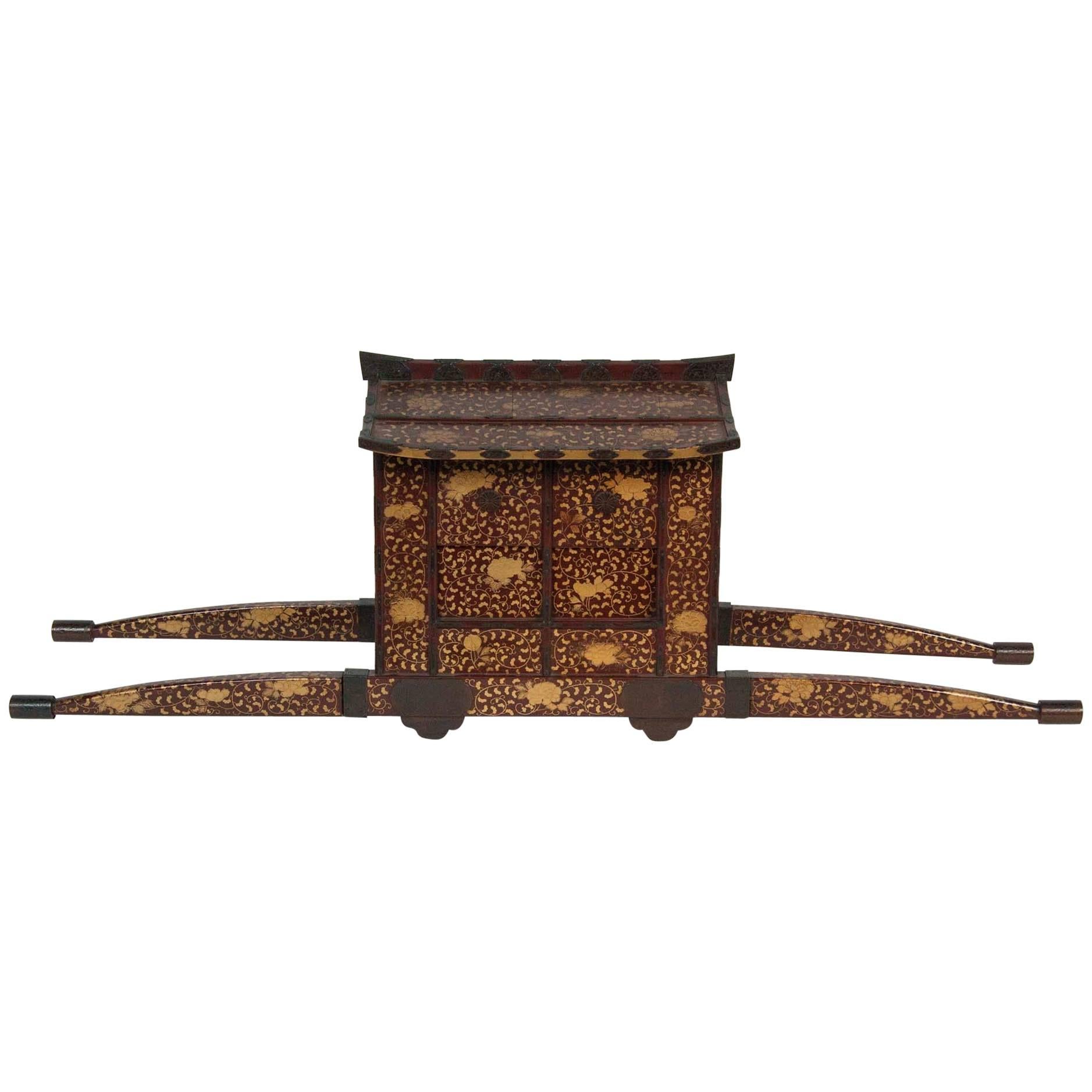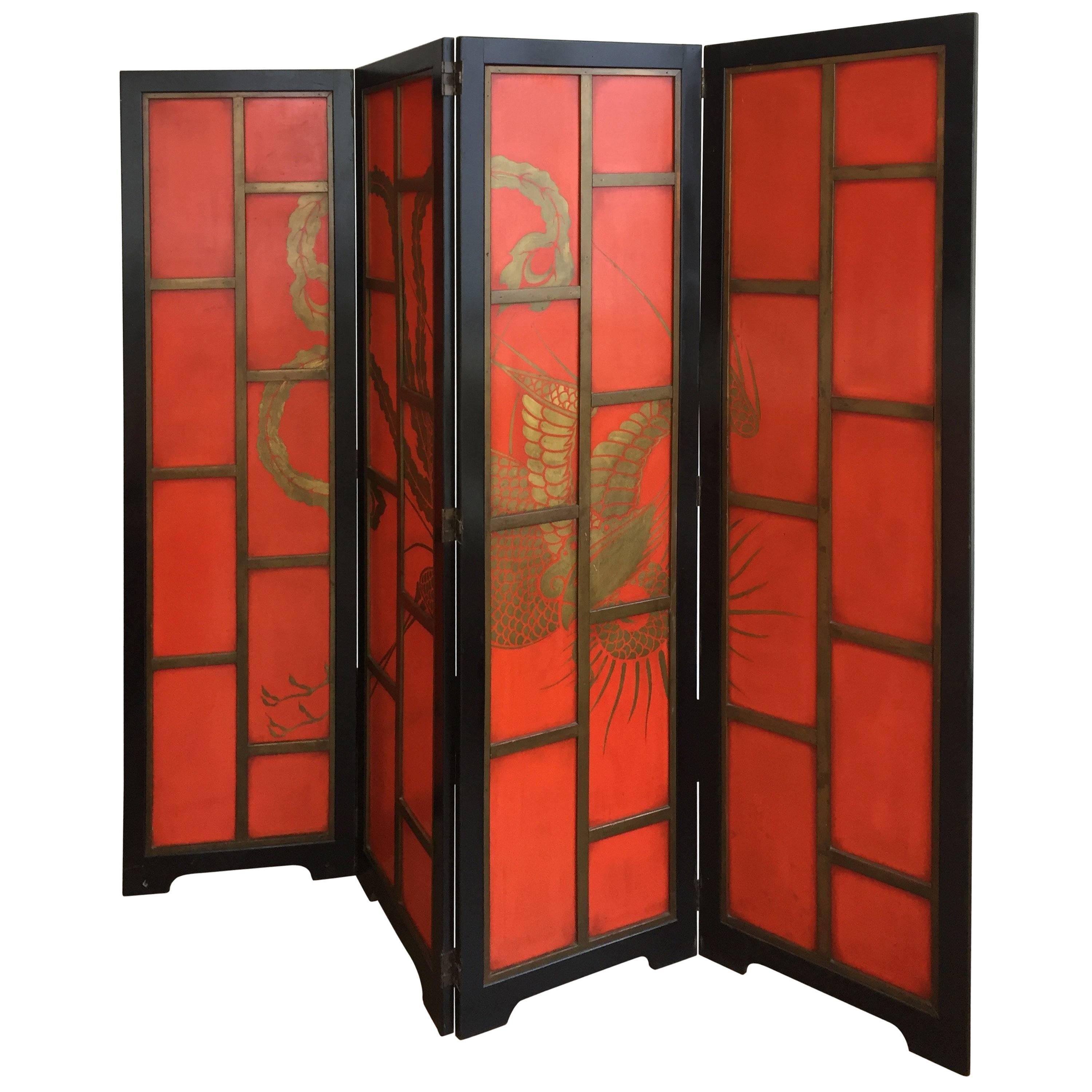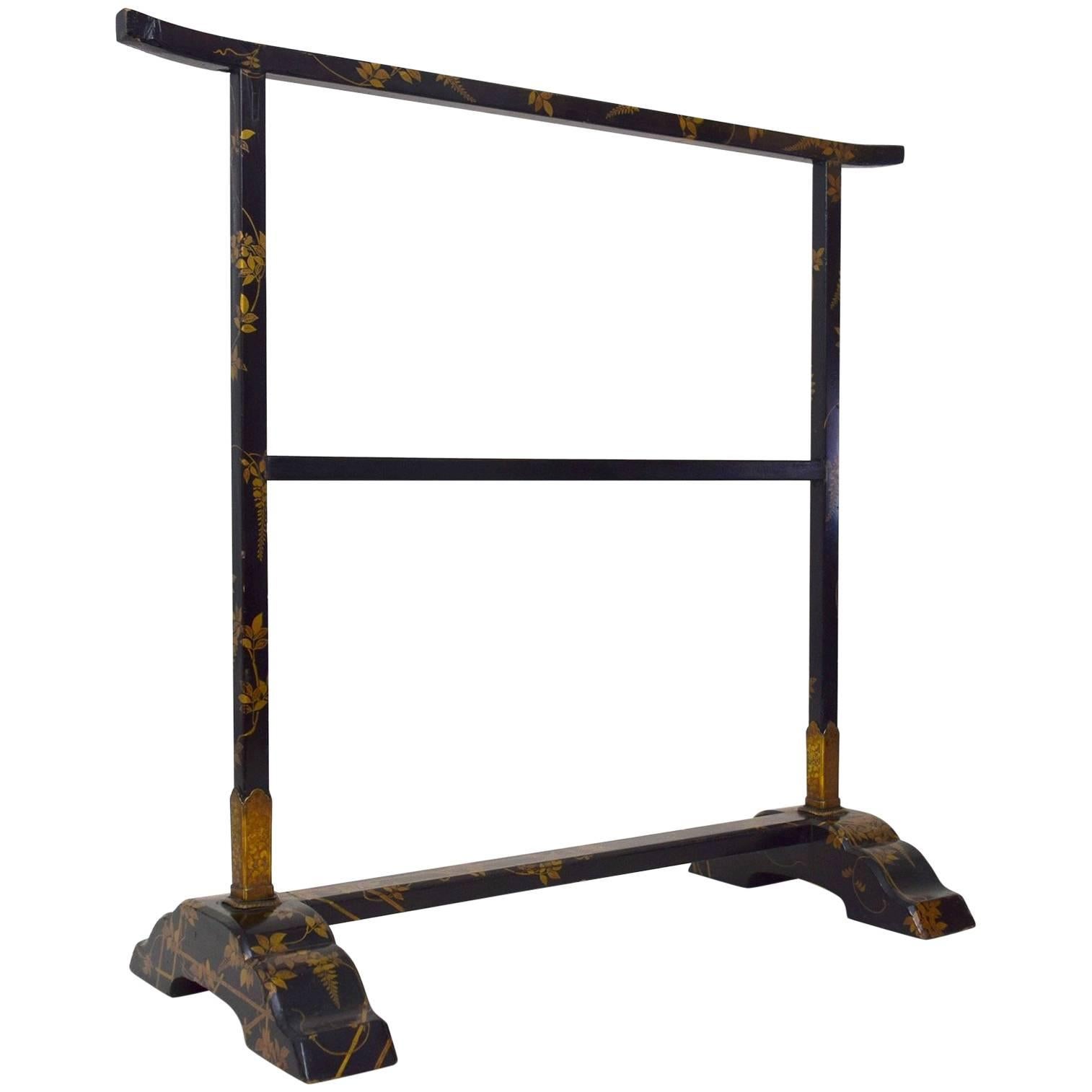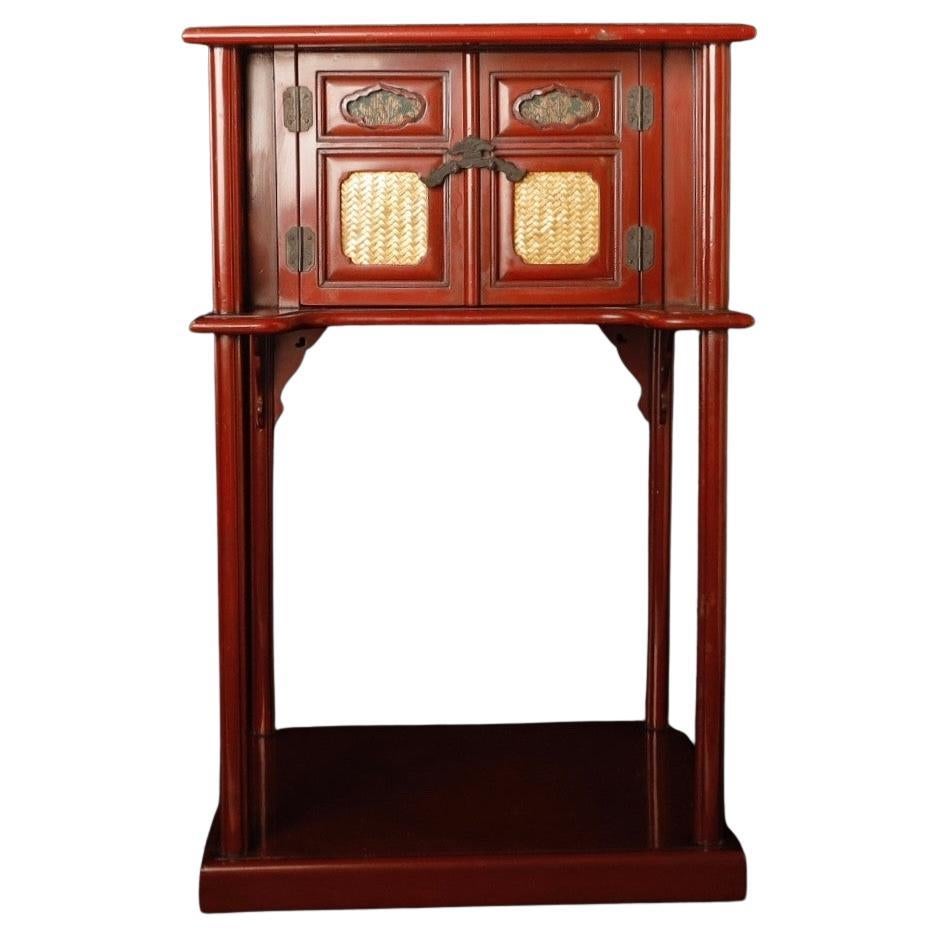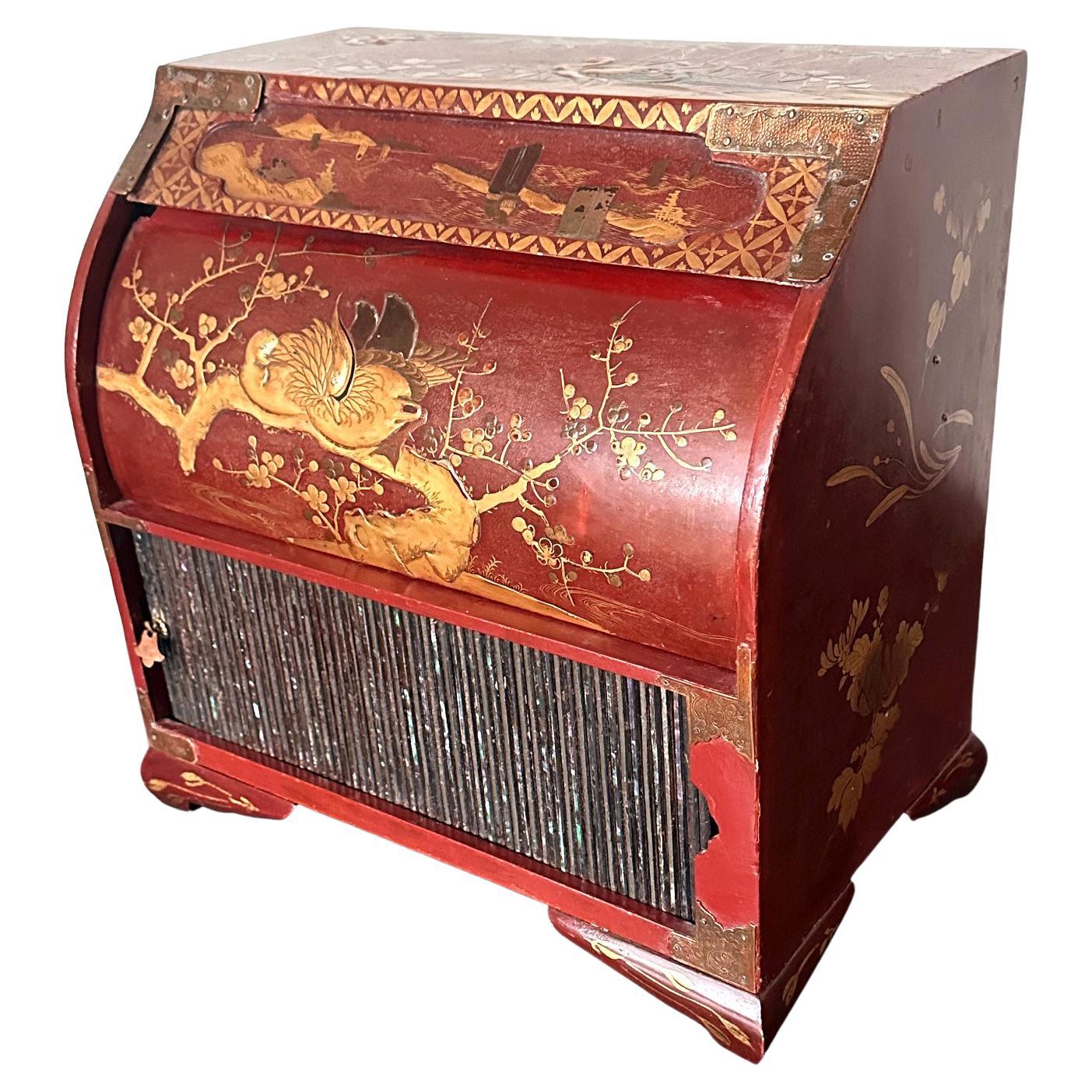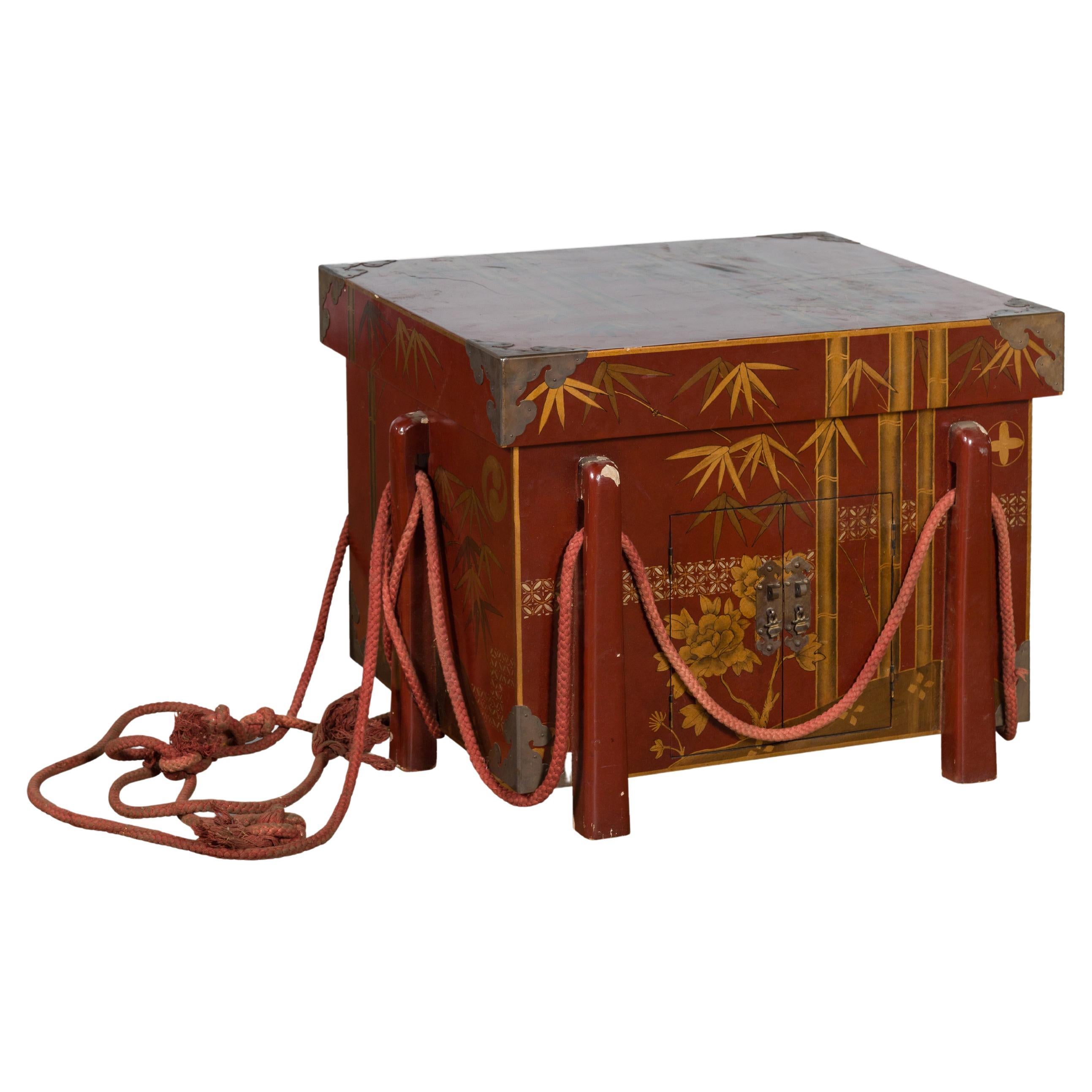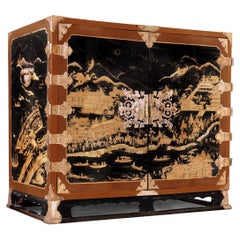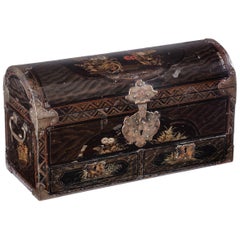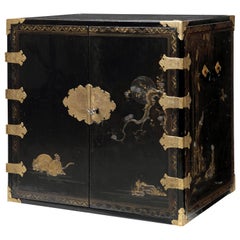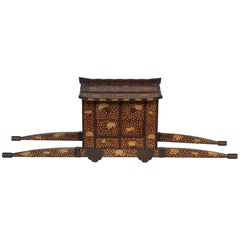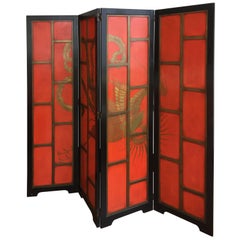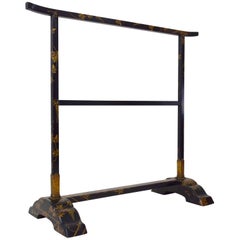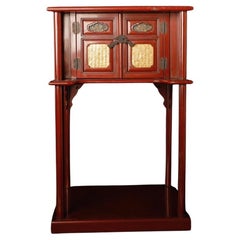Items Similar to Japanese Life-Size, Edo Period, Red and Black Lacquered Palanquin or Norimono
Want more images or videos?
Request additional images or videos from the seller
1 of 10
Japanese Life-Size, Edo Period, Red and Black Lacquered Palanquin or Norimono
$25,000.12
£18,581.89
€21,000
CA$34,518.29
A$38,278.23
CHF 20,112.37
MX$467,694.88
NOK 251,633.17
SEK 236,200.73
DKK 159,904.50
About the Item
A Japanese red and black lacquered palanquin or norimono
Edo period, early 19th century
Made of lacquered wood, latticework and bamboo, black velvet and gauze with gilt scrolling vine decorations, sliding doors and roll-down shutters and engraved copper fittings, with a black lacquered yoke for carrying. It bears mons, emblems identifying Japanese families, at the front and back of the norimono; the gyo~yo~mon, and more specific the hanagyo~yo~ (based on the blossoming apricot). Outside Japan intact norimono’s are rare.
H. 95 x L. 125 x W. 78 cm
Length of yoke: 380 cm
Transport for the Wealthy
The Tokugawa shogunate strictly regulated all overt symbols of status, wealth, and power, such as dress, furnishings, number of attendants and certainly also the form, decor, materials, and number of bearers of the norimono. In the earlier Heinan period, the privilege of riding in a norimono was reserved to the reigning Emperor and his principal consort. By the beginning of the Edo period, the use of palanquins had increased to such an extent that they were in danger of losing their exalted status as symbols of power and privilege. Still the greater the status of the passenger, the more elaborate the palanquin. The simplest type of palanquin, kago, was merely an undecorated, basket-like, open structure made of bamboo, covered by a roof of matting, and carried by two bearers. More elaborate types of palanquins were made of wood, and the term norimono is used to describe ornate palanquins decorated with lacquer and limited to passengers of high status.
Nabeshima Family
In the Edo period the hanagyo~yo~ mon on the present norimono belonged to the daimyo Nabeshima family which ruled over the province of Hizen in the area of Saga and Nagasaki prefecture. The Nabeshima family had close connections with Nagasaki where they were appointed by the Shogu~n to defend the Nagasaki Bay. With an income of 357.000 Koku, the Nabeshima family belonged to the wealthy and important Tozama-Daimyo~ of the Edo period. Nabeshima was a side line of the Sho~ni-clan which after several defeats against the O~uchi and the Ru~zo~ji was in decline and moved to Nabeshima in the province of Hizen where they settled and took the name of the town. In the fight over the dominion of Kyu~shu~, Nabeshima sided with the Ryu~zo~ji-clan but were decisively beaten by the rising Shimazu-clan in 1584. In 1587 Nabeshima sided with Toyomoti Hideyoshi during his invasion of Kyu~shu~. Hideyoshi granted Nabeshima the region round Saga fief in gratitude. The leader of the family Nabeshima, Naoshige, also joined Hideyoshi in his invasion of Korea, as a commander. After Hideyoshi’s death in 1598, a fight for power ensued in which Nabeshima changed sides, but after the final victory of Tokugawa Ieyasu were able to hold on the fief Saga, one of the richest regions of Japan. As an ally of the Tokugawa Shogunate, Nabeshima was decisive in suppressing the Christian Shimabara revolt in Kyushu in 1637. In the Boshin War of the Meiji uprising, Nabeshima joined the Satsuma- Cho~shu~ reform party and although they lost their rule over Saga in the Meiji period, they did remain one of the influential families of the so-called Meiji Oligarchy.
A Dutchman in a Norimono
Some form of human-powered transport, be it a litter, sedan chair or palanquin, is almost universal but particularly in Japan the palanquin, norimono, was very common. Because of the limited availability of grazing in this overcrowded and mountainous country, severe restrictions were placed upon the use of horses for other than military purposes.
Between 1641 and 1860 the VOC was the only European company allowed in Japan. Like all the local Japanese daimyo, the Dutch yearly had to make a voyage from their settlement in the bay of Nagasaki to the court of the Shogun in Edo (Tokyo) to pay their respect and bring presents from the West. This was the only time in the year the Dutch were allowed off their small island of Deshima. They travelled in norimonos like the present one, carried by two or four men. Franz von Siebold described his journey in a norimono: “in such a palanquin the traveller sits on a flat floor covered with mats, bear- or tiger skins. The Japanese are used, from childhood on, to sit on their folded legs. With us only small persons can do so, but for larger persons to sit like that all day in a palanquin is torture!”
After Blomhoff had sent a miniature norimono to the Netherlands for the Royal Cabinet of Curiosities, as part of a complete series of 110 model items depicting the court journey train, his successor as Dutch Opperhoofd in Japan, Johan Willem de Stu¨rler (1774- 1855) in 1834 sent the norimono he travelled into the Netherlands, which now is in the collection of the Museum of World Cultures Leiden. Stu¨rler, as military man involved in one of the battles against France, was injured at his hip and as a result, had difficulties bending one of his legs. Therefore, the norimono that Stu¨rler sent has a hole cut in the foot end so he could stretch his wounded leg. Unlike Siebold, Blomhoff found travelling in a norimono very comfortable although he did say he sometimes descended to stretch his legs during the daily eight-hour journey. A copperplate engraving from Gedenckwaerdige Gesantschappen der Oost-Indische Maatschappy in’t Vereenigde Nederland aen de Kaisaren van Japan, Getrokken uit de Geschriften en Reisaentekeninge der zelver Gesanten, by Arnoldus Montanus, publ. Jacob van Meurs, Amsterdam 1669, shows the procession of the Dutch Opperhoofd on his court journey in a palanquin like the present one (see, Uit Verre Streken, November 2018, item 57). Throughout the Edo period the basic form of the palanquins changed very little. Following the resignation of the last Tokugawa shogun in 1867, there ensued a rapid transformation of the Japanese society. Palanquins, the elite conveyances of the Tokugawa shogunate, were quickly displaced by horse-drawn carriages fashioned after European models and by the jinrikisha, a wheeled vehicle pulled by one man. Few norimono survived intact.
Norimono in Europe
Immediately after the end of the sakoku policy of the closed country and the opening of Japan to the world, the Danish ambassador in Hong Kong, Mr. Block, in 1860 acquired a true norimono for the Royal Ethnographic Museum in Copenhagen, now in the Japanese Department of the National Museum in Copenhagen. A few more were imported into European collections but many of them were either adapted to be used as exotic chairs, as playhouses for children or withered away in barns. Outside Japan an intact one like the present norimono is rare. Only the textile in the windows and the ropes in the bamboo shutters had to be replaced with (original) gauze and ropes from Japan.
- Dimensions:Height: 37.41 in (95 cm)Width: 49.22 in (125 cm)Depth: 30.71 in (78 cm)
- Style:Edo (Of the Period)
- Materials and Techniques:
- Place of Origin:
- Period:
- Date of Manufacture:1800-1810
- Condition:Repaired: Only the textile in the windows and the ropes in the bamboo shutters had to be replaced with (original) gauze and ropes from Japan. Reupholstered.
- Seller Location:Amsterdam, NL
- Reference Number:1stDibs: LU5458229651382
About the Seller
5.0
Recognized Seller
These prestigious sellers are industry leaders and represent the highest echelon for item quality and design.
Established in 1985
1stDibs seller since 2020
23 sales on 1stDibs
Typical response time: 5 hours
- ShippingRetrieving quote...Shipping from: Amsterdam, Netherlands
- Return Policy
Authenticity Guarantee
In the unlikely event there’s an issue with an item’s authenticity, contact us within 1 year for a full refund. DetailsMoney-Back Guarantee
If your item is not as described, is damaged in transit, or does not arrive, contact us within 7 days for a full refund. Details24-Hour Cancellation
You have a 24-hour grace period in which to reconsider your purchase, with no questions asked.Vetted Professional Sellers
Our world-class sellers must adhere to strict standards for service and quality, maintaining the integrity of our listings.Price-Match Guarantee
If you find that a seller listed the same item for a lower price elsewhere, we’ll match it.Trusted Global Delivery
Our best-in-class carrier network provides specialized shipping options worldwide, including custom delivery.More From This Seller
View All17th Century Japanese Export Lacquer Cabinet with Depiction the Dutch Tradepost
Located in Amsterdam, NL
A highly important Japanese export lacquer cabinet with depiction of the Dutch East India Company tradepost Deshima and the annual Dutch delegation on its way to the Shogun in Edo
Edo period, circa 1660-1680
H. 88 x W. 100.5 x D. 54 cm
This cabinet includes a later European japanned stand, but also a modern powder-coated steel frame.
The latter can be designed and added to your specific needs.
The sides and front of the rectangular two-door cabinet are embellished in gold and silver hiramaki-e and takamaki-e on a black roiro lacquer ground with a continuous design. The two doors depict a long procession of numerous figures travelling on foot and horseback along buildings and a pagoda into a mountainous landscape. This is the annual court journey, Hofreis, of the Dutch from Nagasaki to the Shogun’s court in Edo. Three horseback riders are dressed as Dutch merchants and a fourth figure, probably het Opperhoofd, is seen inside a palanquin, norimon. Just about to cross the bridge, two men are carrying a cabinet like the present one.
Many Japanese figures on either side of the procession are engaged in various activities; some play musical instruments on board of small boats, others are fishing; figures inside buildings are depicted playing go, and farmers are tending to their rice paddocks. The upper part of the right door shows a large mansion, probably the local daimyo’s castle, with men kneeling before a man in the central courtyard.
The court journey fits in with the foreign policy of the shogunate which accorded a role to the VOC alongside China, Korea, and the Ryukyu Islands who also had to pay tribute. However, the VOC employees were traders, having low status in Japan’s social hierarchy, and they were received with less deference than were the state embassies from Korea and the Ryukyu Islands. Nevertheless, the contacts with the Dutch were a welcome source of information to the Shogun about Europe and European science and technology.
The left side of the cabinet depicts, in mirror image, a rare view of the artificial fan-shaped Deshima Island, the trading post for the Dutch in Japan. The island, where the Dutch flag flies, is surrounded by small Japanese boats and an anchored three-masted fluyt (cargo ship), flying Dutch flags, with on the stern the VOC monogram. On the bottom right a busy street of Nagasaki is shown, bordered by shops and leading up to the stone bridge. On the island the trees are beautifully painted, two cows can be seen, and the flagpole, all in very fine detail. Dutchmen and enslaved Malay are visible outside the buildings and two Japanese figures, probably guards, sit in a small hut in the centre.
A maximum of fifteen to twenty Dutchmen lived on the island at any time and soldiers or women were not allowed. Restrictions on Deshima were tight, and the merchants were only allowed to leave the island by special permission. The Opperhoofd had to be replaced every year, and each new Opperhoofd had to make a court journey to pay tribute, present gifts, and to obtain permission to Margaret Barclay eep on trading. In the distance, many birds fly above the hills and a four-story pagoda can be seen. The right side of the cabinet is painted with other horse riders and their retinue journeying through mountains.
The pair of doors to the front open to reveal ten rectangular drawers. The drawers are decorated with scenes of birds in flight and landscapes with trees and plants. The reverse of the left door with two thatched buildings, one with a ladder, underneath a camelia tree with large blooms; the right door with a three-story pagoda nestled among trees and both doors with a flying phoenix, ho-oo bird. The cabinet, with elaborately engraved gilt copper mounts, hinges, lock plates and brass handles, is raised on an 18th-century English japanned wood stand.
A pair of large cabinets...
Category
Antique 17th Century Japanese Edo Lacquer
Materials
Copper, Gold
$1,488,102
Free Shipping
Fine Japanese Namban Lacquer Jewelry Casket, 17th Century
Located in Amsterdam, NL
Japanese Namban lacquer transition-style coffer with two drawers
Kyoto/Nagasaki, circa 1650
The cartouches with gilt and red decorations of leaves...
Category
Antique 17th Century Japanese Edo Lacquer
Materials
Cypress
Rare Charming 17th Century Japanese Lacquer Cabinet with Gilt-Bronze Mounts
Located in Amsterdam, NL
A fine Japanese pictoral style lacquer cabinet with gilt-metal mounts
Kyoto, Edo period, 1670-1690
Decorated in Japanese relief lacquer work, black lacquer ground decorated...
Category
Antique Late 17th Century Japanese Furniture
Materials
Bronze
$44,643 Sale Price
25% Off
Free Shipping
Fabulous Lacquer Pagoda Chinoiserie Sculpture with Original Wooden Box
Located in Amsterdam, NL
Wajima lacquer model of a five story-pagoda by the contemporary lacquer master Miyasaki Masahiro.
In the original signed box, including a wooden disp...
Category
Late 20th Century Japanese Showa Lacquer
Materials
Lacquer
Large Royal Early 17th Century Japanese Lacquer Chest with Gilt-Bronze Mounts
Located in Amsterdam, NL
A large Japanese transitional lacquer chest with gilt-metal mounts
Edo period, early 17th century
The rectangular chest with flat hinged lid decorated in gold, silver, and red ...
Category
Antique Early 17th Century Japanese Blanket Chests
Materials
Bronze
Large Japanese Namban Lacquer Coffer Arqueta, 16th Century
Located in Amsterdam, NL
A large Japanese Namban lacquer arqueta coffer for the Portuguese market
Kyoto, Momoyama-period, late 16th century
In Hinoki cypress lacquered in ...
Category
Antique 16th Century Japanese Decorative Boxes
Materials
Mother-of-Pearl, Wood
You May Also Like
Japanese Edo-Meiji Period Lacquered Palanquin
Located in Stamford, CT
A Japanese Edo-Meiji period Palanquin chair for the childrens festival. The form with sliding and hinged doors, decorated in gold hiramaki-e with peonies ...
Category
Antique 1890s Japanese Edo More Asian Art, Objects and Furniture
Materials
Lacquer
Chinoiserie Screen Art Deco Style in Colour China Red and Black Lacquer
Located in Hamburg, DE
Chinese Paravent, Art Deco style, China red lacker, main frame in black lacquer, base material wood, can be used as room divider as back side as a dec...
Category
Vintage 1920s Chinese Art Deco Lacquer
Materials
Wood
Elegant Japanese Edo Period Rack
Located in New York, NY
This refined object dates to the first half of the 19th century, and was probably used for obi, kimono sashes, which were hung over it. The gold decorations on the black-lacquered g...
Category
Antique 1830s Japanese Edo Lacquer
Materials
Lacquer
18th -19th century Japanese Negoro style Lacquered stand
Located in Fukuoka, JP
Very rare early period negoro lacquer buddhist temple worship article stand . Wood with Negoro style lacquer and gilded copper fittings.
Good condition considering significant age...
Category
Antique 18th Century Japanese Edo Furniture
Materials
Wood, Lacquer
Japanese Maki-e Lacquered Wood Kodansu Small Chest with Drawers Meiji Period
Located in Atlanta, GA
An antique Japanese Kodansu with two compartments and multiple drawers with red lacquer finish and gold Maki-e and wonderful Raden shell inlays decoration. This rather unusual piece ...
Category
Antique 19th Century Japanese Meiji Furniture
Materials
Wood, Lacquer
Japanese Vintage Wedding Chest with Red Lacquer and Hand-Painted Décor
Located in Yonkers, NY
A vintage Japanese oxblood red lacquered wedding chest from the mid 20th century, with hand-painted foliage décor, two small doors and ropes. Created in Japan during the midcentury period, this vintage wedding box features an oxblood red lacquer perfectly accented by a gilded hand-painted décor depicting bamboo sticks with their leaves and delicate flowers. Created to be part of the extensive wedding trousseau provided to the daughter, this chest showcases a linear silhouette perfectly complimented by a dark red lacquer. A rectangular lid, adorned with brass corners, opens to reveal a thin black tray. The top and the façade are adorned in continuity with a gilded hand-painted décor showcasing bamboo sticks and their leaves, as well as delicate flowers. Two small doors in the lower section open to a convenient black colored storage space. Wrapped with ropes, this vintage Japanese wedding chest...
Category
Mid-20th Century Japanese Trunks and Luggage
Materials
Rope, Wood
More Ways To Browse
Japanese Rattan Furniture
Japanese Velvet
Japanese Wood Block
Black And Red Lacquer
Japanese Tiger
Japanese Silk Dress
Antique Curiosity Cabinet
Korean Textile
Japanese Edo Period Items
Lacquered Bamboo Chair
Korean Door
Rattan Japan
Exotic Chairs
Mr Rattan Chairs
Meiji Tiger
Rattan Childrens Chairs
Sedan Chair
Japanese Floor Chair
